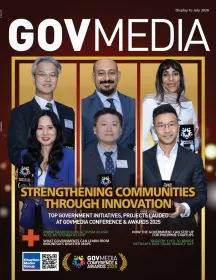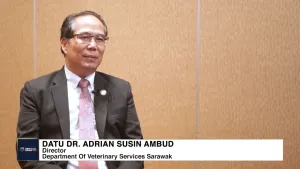
Cities and data driving economic opportunities in our communities: KPMG’s Michael Camerlengo
Michael Camerlengo, Head of Government Sector Asia Pacific at KPMG discusses the key factors shaping the future of governments and organisations.
In an era of rapid economic growth and evolving policy landscapes, the role of experienced professionals in shaping the future of public sector entities and their role in delivering new and exciting forms of public value cannot be overstated.
Michael Camerlengo is a Partner with KPMG based in Sydney and Head of the Government Sector for Asia Pacific. Camerlengo was previously based in Hong Kong with KPMG where he was Head of Infrastructure Sector for China.Camerlengo advises clients primarily in respect of major development and social infrastructure projects, as well as industry policy and reform and socio-economic development programmes. Camerlengo has advised public sector clients across a range of sectors, including health, housing, human services, transport, sports, arts & culture, education, tourism, construction, and real estate.
In this interview, Camerlengo delves deeper into his insights about the evolving landscape of government transformation in the Asia Pacific region.
He stated that there are “three E’s” that are key forms of public value for governments – economic growth, equity in society, and environmental sustainability. The challenge for governments is delivering impacts across these three dimensions and finding balance. Camerlengo believes data, analysis, and business insights are critical in informing government agencies in setting and executing new policies, programmes, and investments that deliver on these opportunities.
Balancing environmental progress with financial sustainability
Countries, provinces, cities, and public sector agencies in Asia Pacific are no strangers to net-zero emission commitments, with an increasing movement towards lightening environmental footprints. However, concerns linger regarding the costs of decarbonisation and achieving net-zero targets whilst balancing financial sustainability objectives.
“Technology is widely recognised as a vital element of the net-zero journey for our region, but this requires investment, advanced research, and community commitment across borders - one country, one city, one township can’t do it alone,” Camerlengo explained.
He added that in terms of solutions development, a multi-stakeholder approach must be taken through partnerships with big businesses, technology firms, and academia – but with leadership, drive, regulation, and seed investment from governments. This provides a well-informed model for shaping future policy and regulation, with the potential to drive more rapid environmental progress.
Camerlengo further highlighted the importance of delivering economic growth whilst fostering social equity to ensure that investments can continue sustainably without risking the withdrawal of the public sector, private sector, and community commitment.
Amidst the growing demand for environmental action, governments in the Asia Pacific have an opportunity to accelerate their digital transformation journey – both in the services delivered to citizens and the business of government in transforming its ways of working and functional activities.
Camerlengo noted two macro-factors that can highly influence outcomes. The first is focussing on business needs over technology for the sake of technology. In other words, what problems and improvement opportunities exist in the system, and how can technology be deployed to resolve them. Technology simply used to replace and mirror existing ways of working and servicing citizens will leave benefits on the table.
The second involves positioning ‘purpose’ at the heart of the transformation journey. Workforce and back-office transformation initiatives; data-driven digital solutions and service provision; and placemaking infrastructure projects that deliver greater services to citizens and communities are all areas that can all contribute value, regardless of where the public sector body sits on the digital spectrum. This means being clear about the economic, social, and environmental “purpose” of such initiatives from the outset to the completion of a transformation journey.
Opportunities for economic and social growth
Various economic and geopolitical challenges are impacting government and public sector bodies in the region but Camerlengo believes there are still exciting areas of opportunity, particularly in cities, infrastructure, and regionalisation.
During the height of the pandemic, cities in our region faced significant pressures, with many business and service professionals and their families moving to regional locations, work-from-home lessening inner-city vibrancy, tourism declines, job swaps, and decreased office utilisation, amongst others. Though many of these trends are now being reversed – some appear to be permanently entrenched.
“Whilst city governments continue to push hard to bring citizens back to central business districts to grow consumer and business expenditure, regional and outer urban areas continue to hold a level of ‘stickiness’ through lifestyle options and the global work-from-home trend,” Camerlengo pointed out.
Governments in certain jurisdictions are responding to the changing landscape by implementing decentralised or polycentric city and regional growth models. Some of these include New South Wales in Australia with its strong focus on investing in regional growth areas such as Newcastle and Wollongong in addition to leveraging the catalytic impact of the new Western Sydney International Airport that is driving the development of the new city centre of Bradfield 65km west of the traditional Sydney CBD. Hong Kong has also initiated a similar approach with the development of the Northern Metropolis and Kau Yi Chau Artificial Islands Projects. A similar strategy was also being adopted in New Clark City in the Philippines and the “independent cities” (new cities developed by the private sector) trend witnessed in Indonesia prior to the pandemic.
This trend is expected to gather pace in the coming years, with government entities tapping into new opportunities for economic growth, community infrastructure, social development programmes, technological advancements, and ESG initiatives. “Whilst supporting traditional central business district locations that attract business investment, talent, and tourism, governments are actively pursuing the potential of polycentric city models” Camerlengo noted.
Meanwhile, one of the biggest global issues highlighted by the COVID-19 pandemic was inequity in society. Governments are looking at new ways to drive opportunities for those in marginalised and vulnerable communities, address gender imbalances in the workforce, deliver greater community engagement and opportunities for youth groups and lift levels of cultural inclusiveness.
Governments will be more empowered to increase commitment levels in this realm by shifting the public discourse from “social cost” to “social investment” and better articulating the medium and long-term economic benefits that will flow by enabling these groups enhanced access to public services, education, and employment. In other words, social investment for medium and long-term economic and community benefits.
This trend is evident in Australia, where the NSW Government is delivering on its commitment to address the cost of living and housing crisis in the state with a focus on well-located homes close to modern infrastructure, jobs and transport. As the housing supply in NSW fails to keep pace with demand, the NSW government aims to create a new state-wide policy that will increase supply and drive down the cost of housing affordability.
Camerlengo identifies that the NSW Government is utilising its multi-billion dollar investment in transport infrastructure to accelerate the re-zoning of eight transit-orientated developments. These “TODs” will enable the development of over 47,000 well-located high and mid-rise homes in prime sites located next to hubs of jobs and public amenities.
The combination of well-planned transport infrastructure, innovative housing policies, and the attraction of future-focussed industries are critical elements to delivering equitable economic and social outcomes for society.













